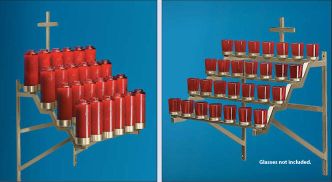

Q. 1. What is the purpose of the candle holders?
A. 1. In the Roman Catholic Church, candles are placed before a statue of Jesus or of the Blessed Virgin Mary. Often, in older or traditional churches, this will be before a side Altar. Candles used may vary from long, taper-type candles to tealight candles. Tealight candles are either placed in holders or just on a platform in front of the statue. Long candles may be placed in a special holder.
Nowadays, because of high insurance rate, Churches that still do have candle holders, tend to have tealight candles that are placed in a glass candle holder, ensuring these short term 5 hour candless will be burned out before the end of the day so nothing will burn during the night when the Church is unattended.
Candles are lit for prayer intentions. To "light a candle for someone" indicates one's intention to say a prayer for another person, and the candle symbolizes that prayer. Many times, "a board is placed nearby with names of those for whom prayer is requested." A donation box sometimes is placed near a tealight candle rack so the faithful member of the Church who lights the tealight candles can help defray the cost of the tealight candles.
Votive candles are made from different types of waxes including paraffin, soy wax or beeswax. There are different grades of wax with different melting points. Paraffin is often mixed with other types of waxes, such as beeswax or vegetable wax. This is done to obtain the rigidity necessary for the type of candle being made. The speed at which the candle burns depends on the composition of the wax. A taper candle that sits in a ring-shaped candle holder may have a low melting point and produce little to no oil, whereas a votive candle set in a glass cup may have a very low melting point and turn to oil. Pillar candles, large candles often with multiple wicks, have their own formula. Soy jar candles tend to have a lower melting point than pillars and votive candles. Candle quality also varies widely depending on the candle maker. The aroma of a lighted scented candle is released through the evaporation of the fragrance from the hot wax pool and from the solid candle itself.
Lead wicks are unlikely to be found in any candle sold in the U.S. today: lead-core wicks have been banned from the U.S. since 2003, and members of the National Candle Association — which account for more than 90% of candles made in the U.S. — have not used lead wicks for more than 30 years. Reputable manufacturers use cotton, cotton-paper, zinc-core or tin-core wicks, all of which are known to be safe.